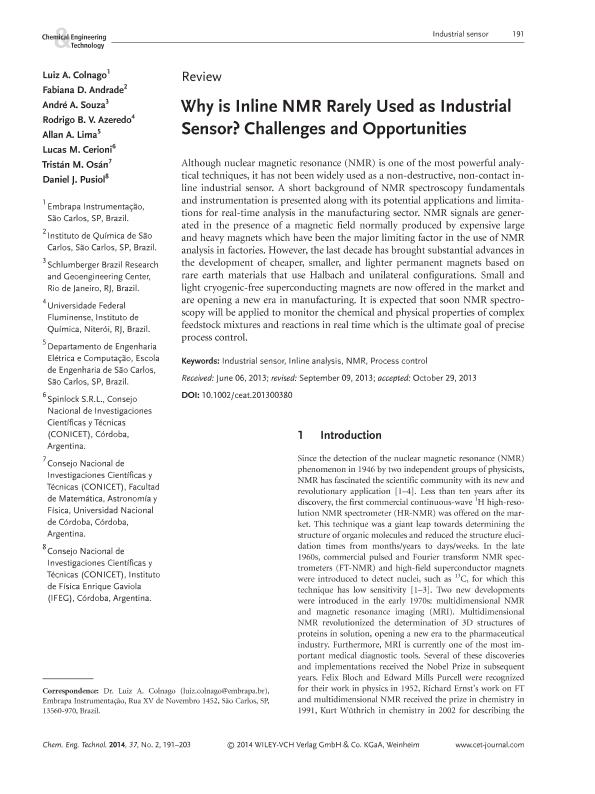Artículo
Why is Inline NMR rarely used as industrial sensor? Challenges and opportunities
Colnago, Luiz A.; Andrade, Fabiana D.; Souza, André A.; Azeredo, Rodrigo B. V.; Lima, Allan A.; Cerioni, Lucas Matias Ceferino ; Osán, Tristán Martín
; Osán, Tristán Martín ; Pusiol, Daniel Jose
; Pusiol, Daniel Jose
 ; Osán, Tristán Martín
; Osán, Tristán Martín ; Pusiol, Daniel Jose
; Pusiol, Daniel Jose
Fecha de publicación:
12/2013
Editorial:
Wiley VCH Verlag
Revista:
Chemical Enginnering Technology
ISSN:
0930-7516
e-ISSN:
1521-4125
Idioma:
Inglés
Tipo de recurso:
Artículo publicado
Clasificación temática:
Resumen
Although nuclear magnetic resonance (NMR) is one of the most powerful analytical techniques, it has not been widely used as a non-destructive, non-contact inline industrial sensor. A short background of NMR spectroscopy fundamentals and instrumentation is presented along with its potential applications and limitations for real-time analysis in the manufacturing sector. NMR signals are generated in the presence of a magnetic field normally produced by expensive large and heavy magnets which have been the major limiting factor in the use of NMR analysis in factories. However, the last decade has brought substantial advances in the development of cheaper, smaller, and lighter permanent magnets based on rare earth materials that use Halbach and unilateral configurations. Small and light cryogenic-free superconducting magnets are now offered in the market and are opening a new era in manufacturing. It is expected that soon NMR spectroscopy will be applied to monitor the chemical and physical properties of complex feedstock mixtures and reactions in real time which is the ultimate goal of precise process control.
Palabras clave:
Industrial Sensor
,
Inline Analysis
,
Nmr
,
Process Control
Archivos asociados
Licencia
Identificadores
Colecciones
Articulos(CCT - CORDOBA)
Articulos de CTRO.CIENTIFICO TECNOL.CONICET - CORDOBA
Articulos de CTRO.CIENTIFICO TECNOL.CONICET - CORDOBA
Citación
Colnago, Luiz A.; Andrade, Fabiana D.; Souza, André A.; Azeredo, Rodrigo B. V.; Lima, Allan A.; et al.; Why is Inline NMR rarely used as industrial sensor? Challenges and opportunities; Wiley VCH Verlag; Chemical Enginnering Technology; 37; 12-2013; 191-203
Compartir
Altmétricas



